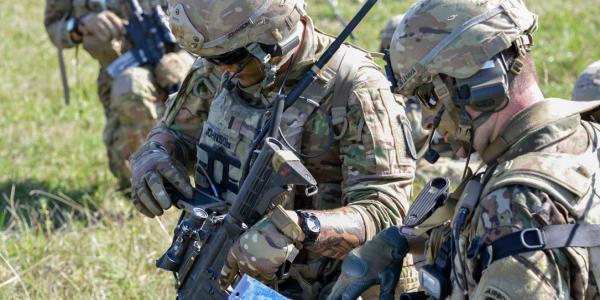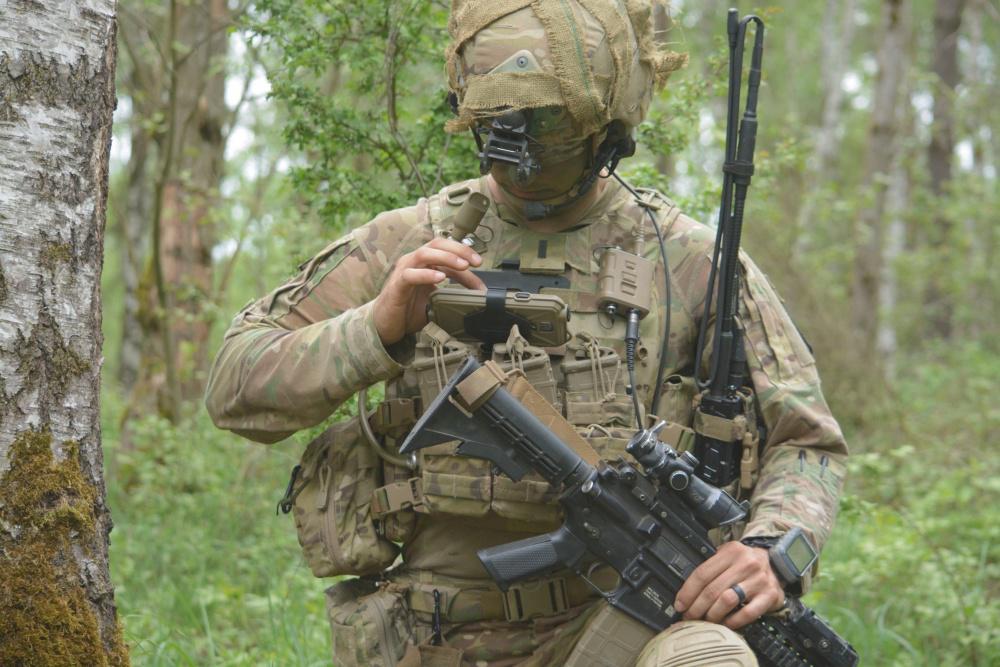Connecting on a Disconnected Battlefield
The U.S. Army’s current tactical network environment is not optimized to provide expeditionary, mobile, hardened or simple intuitive network capability under all conditions. Its full range of communication capabilities provides the communications backbone across all echelons, but if commanders face a disconnected intermittent limited situation such as during an electronic warfare attack, they must have the ability to turn to alternate communication methods or pathways.
This multipath diversity is especially critical during expeditionary, early entry, early phase operations when soldiers rely heavily on effective communications to initiate their missions before vehicles and other high-capability systems join the fight.
To meet this demand and as a key part of its network modernization strategy, the Army is incorporating new commercial components and transport capabilities to enable network communications in disconnected intermittent limited environments. The Integrated Tactical Network (ITN) will provide commanders with resilient communications as part of their primary, alternate, contingency and emergency communications plan.
The core capability primarily consists of commercial equipment; the challenge is integrating the new systems to function with and enhance the Army’s current fielded network. The Army anticipates fielding ITN solutions as part of capability sets on an incremental basis starting in 2021. The network design decisions will be informed by experimentation and operational tests.
The ITN is not a separate network that replaces current Army systems. Instead, it injects new commercial components and network transport capabilities into the Army’s tactical network environment.
The core technologies integrate with other network transport and mission command applications to provide more expeditionary and resilient communications options. The ITN initiative connects the components to take advantage of a diverse set of paths, enabling intuitive and resilient communications under disconnected intermittent limited conditions.
Components include single channel and two-channel leader radios with advanced networking waveforms, handheld Link 16 radios, radio gateways, tethered drones to extend network range, small aperture satellite terminals, commercial smartphone technology, 4G LTE, Wi-Fi and associated ancillary devices.
Delivering applications through a Nett Warrior end-user device, the ITN consolidates the air, ground and fires pictures onto a single secure common operating picture. The user can track the assault elements’ progress across an objective with confidence using the Nett Warrior’s software-based Android Tactical Assault Kit.
The ITN also augments high-bandwidth tactical network connections with commercially developed products that provide additional resilience, including in areas where satellite communications aren’t available. It expands basic command and control and situational awareness at command posts and air and ground vehicle platforms beyond a single-threaded satellite communications implementation for additional resiliency and capacity.
In addition, the network seamlessly integrates and routes data among any available wireless network paths and integrates network operations functions in a cohesive and simple-to-use interface that automates management and configuration capabilities. The ITN also deploys software-reprogrammable handheld and air and ground vehicle-mounted tactical radios that can perform direct legacy interoperability as well as implement modern and evolving wireless waveform standards.
The ITN adds a secure but unclassified (SBU) security enclave to the Army’s Suite A-only network, which currently restricts communications across a single-path transport and does not provide commanders communication pathway options.
Because the majority of tactical information below the battalion level is time-sensitive and unclassified, a Suite A network is not necessarily optimal in all operating conditions. However, the ITN SBU leverages a combination of military and commercially available networks offering multipath diversity. This feature augments soldiers’ primary, alternate, contingency and emergency plans because it protects data based on classification not on arbitrary network boundaries.
While SBU information is not classified, the ITN’s multiple layers of encryption protect data transmitted over military or commercial networks, the Internet, cellular networks or compatible but nonmilitary waveforms.
Other benefits include simplified training, setup and employment of the network, which speeds up planning time and creates a more collaborative planning environment, including communications with joint and coalition partners.
The foundation of the ITN test strategy is a series of continuous, synchronized assessments and evaluations, including developmental tests, experimentations and operational test activities. Data from these events will enable quicker Army ITN network design decisions and allow integrators and developers to work with users and vendors as enhanced and new capability is added.
The Army began ITN assessments in fiscal year 2017 with initial capability focused on SBU components, including data collection activities. Continual testing through fiscal year 2018 included lab-based developmental tests, unit operational assessments and an end-to-end network integration evaluation, operational cyber and electronic warfare test.
These activities continue to inform technology decisions, vendor and resourcing decisions, and feedback for developmental operations of the network as the Army proceeds to full brigade combat team ITN assessments.
The Army also is standing up an ITN integration facility that will connect to the distributed lab ecosystem at Aberdeen Proving Ground, Maryland. This construct will add essential developmental test capabilities such as virtual and also modeling and simulation environments to help with performance, functionality and scalability testing. Live testing will continue to be conducted at unit rotational and training sites and exercises such as Joint Warfighter Assessments and Army warfighting experimentations.
Data collected at these events has assisted in design considerations regarding capability integration, operational environment impacts, vehicle characterization, air-to-ground fires, mission command/situational awareness data transport and survivability of systems in contested and congested hostile environments. This approach will inform network design across infantry, Stryker and armor formations.
Following the initial experimentation events with the 1-508th Parachute Infantry Regiment of the 82nd Airborne Brigade; the 1st Security Force Assistance Brigade, which has a subset of ITN equipment; and the 2nd Cavalry Regiment, the Army plans to implement iterative ITN capability developmental operations experimentation. A series of smaller-scale experiments will lead up to an infantry brigade combat team operational assessment in fiscal year 2020 followed by armored brigade combat team and Stryker brigade team events over the subsequent four fiscal years.
As the lead Army organization for fielding and developing tactical network systems, Program Executive Office Command, Control and Communications–Tactical, in coordination with Program Executive Office Soldier, procures and integrates all necessary hardware, software and ancillary devices for brigade combat team-level experimentation and demonstrates the operational capability required by maneuver forces.
Both organizations have fielding representatives with security force assistance brigade units that help to integrate and troubleshoot systems as well as train soldiers while gathering real-time user feedback for improvements and informing ITN techniques and procedures.
The program executive offices are working closely with the Network Cross Functional Team on the experimentation and proof-of-concept efforts underway with U.S. Army Forces Command units while ensuring all of the efforts align with the Army network’s four lines of effort: unified network transport, joint and coalition interoperability, common operating environment and command post mobility and survivability.
Because the ITN is an iterative concept, as leap-ahead capabilities mature, the Network Cross-Functional Team will leverage experimentation to bring them into the ITN concept. Emerging technologies include low-earth-orbit satellites, new waveforms, cross-domain solutions and artificial intelligence/machine learning.
The Army intends to field initial ITN capability in sets to four infantry brigade combat teams starting in fiscal year 2021. Each fielding year, additional sets will be fielded to priority infantry units. Experimentation with Stryker and armor formations will guide subsequent sets designed specifically for those brigades. The program offices anticipate fielding Stryker capabilities starting in fiscal year 2023 with armor capabilities fielding starting in fiscal year 2025.
By bringing higher bandwidth as well as more robust, agile and reliable networks to the tactical edge, initial ITN experimentation has demonstrated promising solutions to existing gaps in the current network architecture.
Experimentation has shown that ITN efforts provide commanders with multiple network transport path options to take advantage of both commercial and military networks. By incorporating commercial components into the network, units can achieve the secure exchange of information through a unified yet diverse network for an expeditionary, simplified, independent network primarily at battalion down to the small-unit dismounted leader.
The ITN’s expeditionary and resilient communications capabilities will be part of the Army’s solution to achieving its “fight tonight” capability as it strives to ensure not just parity but overmatch when facing future adversaries.
Lt. Col. Brandon Baer, USA, is the product manager for Helicopter and Multi Mission Radios, Program Executive Office Command Control Communications–Tactical.
Lt. Col. Vinson “Vince” Morris, USA, is the product manager for Program Executive Office Ground Soldier Systems, Program Executive Office Soldier.
Kathryn Bailey is a public communications specialist for Bowhead Business and Technologies Solutions assigned to Program Executive Office Command Control Communications–Tactical.






Comment
very informative and well
very informative and well written
Comments